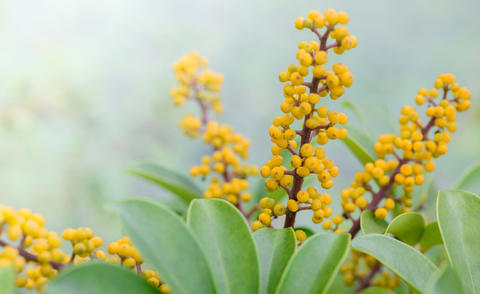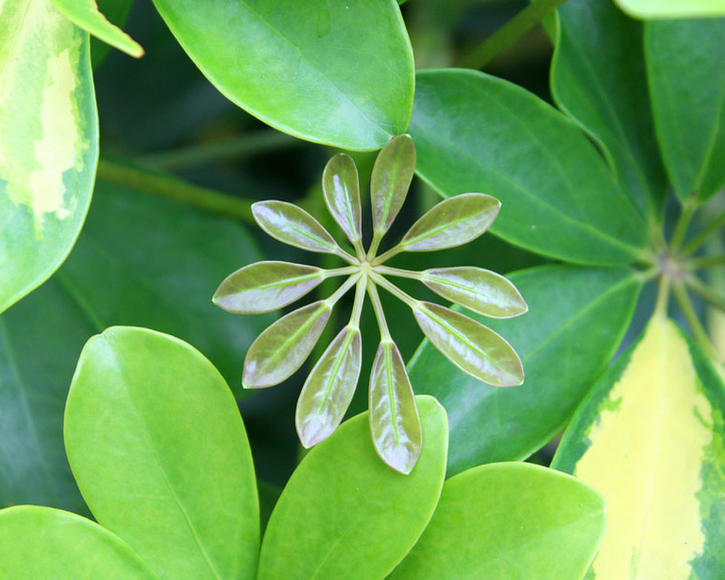Schefflera, Umbrella tree
As a houseplant, the Schefflera or Umbrella tree can be found in practically every home and office. The vigorous foliage ornamentation plant is very robust. You can read about what you still need to look out for when planting and caring for the plant here.
Factsheet
- Growth type
-
- Tree
- Growth height (from)
- from 100 cm to 200 cm
- Growth width (from)
- from 40 cm to 60 cm
- Growth characteristics
-
- upright
- Flower color
-
- green
- yellow
- Flower shape
-
- Panicules
- Leaf color
-
- green
- page format
-
- fingered
- Sheet properties
-
- evergreen
- Fruit color
-
- orange
- red
- Fruit shape
-
- Berry
- Light
-
- scattered light to semi-shade
- Soil Moisture
-
- moderately dry to fresh
- ph value
-
- neutral
- Lime compatibility
-
- lime-tolerant
- Nutrient requirements
-
- nutrient-rich
- Humus
-
- rich in humus
- Decorative or utility value
-
- Leaf ornaments
- Toxicity
-
- non-toxic
- Use
-
- Interior greening
- Planters
- Winter garden
- Garden style
-
- Pot garden
The Schefflera (Schefflera arboricola) originates from Taiwan. It is also sometimes known as the “Umbrella tree" due to the radially arranged, shiny, green leaves on this exotic plant. The Schefflera is one of the most popular houseplants and is also prized as an titleoffice plant, as it is very easy to care for and has grows profusely (up to 12 inches per year). It is generally commercially available fixed to a moss trunk.
The evergreen umbrella tree grows straight up and slender and can reach over 100 feet tall. As it has hardly any branches, you can achieve improved density if you place several young plants or cuttings in one pot. In its tropical native region, the plant grows into a stately tree.
The leaves of the Schefflera grow up to 5.12 inches long. They are alternating and arranged 9 to 15 point palmate. The lamina are shiny.
The Schefflera rarely flowers with indoor cultivation. If it does, it shows star-shaped, green-yellow panicles from July to August. This can be expected particularly in older specimens.

The Umbrella tree develops multiple fruit in the shape of orange-red berries.
As far as location is concerned, the Schefflera is a suitable candidate for somewhat darker corners in the home or office. It does like light conditions, but also thrives in semi-shade. Direct sunlight should be avoided. It even tolerates dry, heated air - but it reacts to a draft by quickly dropping its leaves. Its slender growth also makes it ideal for corners and niches. It can also frequently be found in conservatories.
The Schefflera thrives readily in standard soil and also in hydroponic cultivation.
The soil should be kept moderately moist. If the Schefflera is standing in too much water it will quickly develop root rot.
The Umbrella tree should be given flower food weekly. Fertilizing once a month is sufficient during the winter.
Young plants must be usually be re-potted annually. Less frequent re-potting is sufficient later. Practice has proven that over-long roots should be trimmed and dead or rotten roots completely cut off before moving the Schefflera to a new pot.

In native residencies, it is only the room ceiling which limits the growth of the Schefflera. In order to prevent it reaching such heights, it should be regularly trained into the desired shape through pruning and trimming. Shrubby growth is promoted through trimming the side and main shoots. Just like the weeping fig and serpent tree, the Schefflera belongs to the woody plants and can be trimmed just like open land wood. For this, trim the long or bothersome shoots to just above a bud or on a branch fork. This enables the growth shape to be corrected and long-stemmed specimens can be kept compact. Pruning houseplants which have lost a lot of foliage in the winter stimulates the formation of new shoots.
In the summer, the Umbrella plant does well in the fresh air on the balcony or terrace. You should choose a semi-shady, sheltered spot for it. A warm summer rain does it no harm. However, it shouldn’t be kept in temperatures below 59 degrees Fahrenheit, and at night no lower than 50 degrees Fahrenheit. If the temperature is too low or the location too dark, the Schefflera will drop its leaves. If it is much too warm, this leads to spreading and it loses its compact growth. Tip: Leaves should be occasionally showered or wiped with a damp cloth for the leaves of the Dwarf Umbrella tree to retain their beautiful shine.
As well as dark green, there are also yellow and white-green spotted Schefflera. However, the varieties with colorful foliage require more light than their green relatives and prefer a somewhat lighter spot. If they are kept somewhere too dark, the leaves also become darker. There are numerous varieties with various leaf shapes commercially available. The selection ‘Diane’, ‘Renate’ (with slitted leaves) and ‘Beauty’ are particularly beautiful. ‘Gold Capella’, ‘Trinette’ and ‘Janine’ have light, variegated leaves.
Green house plants such as the Umbrella tree can improve the indoor climate in offices and bedrooms, in particular. The larger and more vigorous the plant, the better its ‘cleaning effect’. The Schefflera binds harmful substances such as formaldehyde and benzene in the breathing air, which is often contained in furniture, cleaning agents and adhesives, as well as nicotine. According to model calculations from the University of Cologne, a 5 foot tall Schefflera produces around 34 gallons of oxygen every hour. In addition, during the course of a day it can remove a full 2.2 gallons of carbon dioxide from the indoor air. This is no replacement for regular ventilation, but it is beneficial for health and an impressive performance for a houseplant.
Non-woody cuttings can be used for regeneration and propagation. These generally take root reliably in a water glass or in soil over 64 degrees Fahrenheit. Seeds sowing is possible all year round in warm locations. The Schefflera takes two to three weeks to germinate.
The reputation of the umbrella tree as a robust houseplant is fully justified, provided its requirements are met. Nonetheless, it should be regularly checked for spider mite, mealy or scaly but infestations in the winter months. These spare almost no houseplant. In a conservatory, it is also advisable to keep a look out for aphids.


